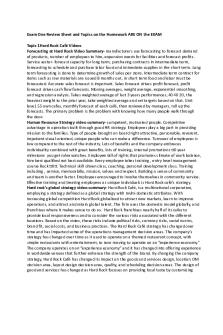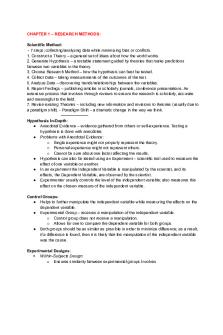Exam Review - Lecture notes 7 PDF

| Title | Exam Review - Lecture notes 7 |
|---|---|
| Course | Organizational Behavior |
| Institution | Prince Mohammad Bin Fahd University |
| Pages | 6 |
| File Size | 96.4 KB |
| File Type | |
| Total Downloads | 56 |
| Total Views | 147 |
Summary
Review of four chapters...
Description
What is Organizational Behavior and what is its chief goal? Organizational behavior is the study of individual, group, and structure behaviors and how it affects organizations. Its chief goal is to apply that knowledge toward improving an organization’s effectiveness.
Why is it important to complement intuition with systematic study in our attempts to understand behavior within organizations? Answer:
It is important to complement intuition with systematic study to understand
behavior within organizations in order to make accurate predictions of behavior. Underlying this systematic approach is the belief that behavior is not random. Rather, one can identify fundamental consistencies underlying the behavior of all individuals and modify them to reflect individual differences. The systematic study of behavior is a means to making reasonably accurate predictions. Systematic study involves looking at relationships, attempting to attribute causes and effects, and basing our conclusions on scientific evidence, that is, on data gathered under controlled conditions and measured and interpreted in a reasonably rigorous manner.
104) What is evidence-based management (EBM)? Answer: Evidence-based management (EBM) complements systematic study by basing managerial decisions on the best available scientific evidence. For example, we want doctors to make decisions about patient care based on the latest available evidence, and EBM argues that managers should do the same, becoming more scientific in how they think about management problems. A manager might pose a managerial question, search for the best available evidence, and apply the relevant information to the question or case at hand.
107) Why do only a few absolutes apply to organizational behavior? Answer: Human beings are complex, and few, if any, simple and universal principles explain organizational behavior. Since we are not alike, our ability to make simple, accurate, and sweeping generalizations is limited. For instance, two people often act very differently in the same situation, and the same person's behavior changes in different situations. Not everyone is motivated by money, and people may behave differently at a religious service than they do at a party. That does not mean, of course, that we cannot offer reasonably accurate
explanations of human behavior or make valid predictions. It does mean that OB concepts must reflect situational, or contingency, conditions.
What are the contributing disciplines to the OB field? It consists of micro-levels (the individual), and macro-level (groups and organizations). -
Psychology: the scientific study of the mind and behavior
-
Social psychology: branch of psychology that deals with social interactions
-
Sociology: the study of social problems.
-
Anthropology: the scientific study of humans, human behavior and societies in the past and present
* OB concepts must reflect situational conditions: contingency variables
List 4 challenges and opportunities in OB. -
The workplace is contains a wide mix of cultures, races, ethnic groups, genders
-
Employees have to learn to cope with rapid change due to global competition
-
Corporate loyalty has decreased due to corporate downsizing and use of temp workers
-
Managers can benefit from OB theory and concepts
List 3 insights OB offers. -
Improving quality and productivity
-
Customer service and building a customer-responsive culture
-
Developing people skills
What does OB aid in dealing with? -
Stimulating Innovation and Change
-
Increasing “temporariness” in the workplace
-
Helping employees balance work-life conflicts
-
Improving ethical behavior
What are the three level of OB analysis? 1- Organization level 2- Group level 3- Individual level
How can OB help with some of the implications managers face? -
Insights to improve people skills
-
Valuing of workforce diversity
-
Empowering people and creating a positive work environment
-
Dealing with labor shortages
-
Creating an ethically healthy work environment
What is the goal of organizational behavior? to understand and predict human behavior in organizations.
Define leadership. The process of developing ideas and a vision, living by values that support those ideas and that vision, influencing others to embrace them in their own behaviors, and making hard decisions about human and other resources.
What is a manager? Directs, controls, and plans the work of others and is responsible for results.
Define authority, responsibility, and accountability.
authority is the right to make decisions, responsibility is the assignment for achieving a goal, and accountability is the acceptance of success or failure.
Define self-competency. The knowledge, skills, and abilities to assess your personal strengths and weaknesses, set and pursue professional and personal goals, balance work and personal life, and engage in new learning.
List the five attributes to self-competency. -
Understanding own and others personality and attitudes
-
Perceiving, appraising, and interpreting accurately
-
Understanding and acting on work-related motivations and emotions
-
Assessing and establishing developmental, life-related, and work-related goals
-
Taking responsibility for managing yourself and your career and through successful circumstances
What are the sources of personality? -
Heredity
-
Environment (e.g., Culture, Family, Group Membership, Life Experiences)
What are the influences of culturally based work-related values? -
Individualism-Collectivism
-
Power Distance
-
Uncertainty Avoidance
-
Gender role Orientation
-
Long-term Orientation
Other Factors that Affect Personality
Family: socioeconomic level
Group membership: family, social groups, organization.
Life experiences
What are the “Big Five” Personality Factors? 1- Emotional stability: (Stable, confident, effective) or (Nervous, self-doubting, moody) 2- Agreeableness: (Warm, tactful, considerate) or (Independent, cold, rude) 3- Extraversion: (Gregarious, energetic, self-dramatizing) or (Shy, unassertive, withdrawn) 4- Conscientiousness: (Careful, neat, dependable) or (Impulsive, careless, irresponsible) 5- Openness: (Imaginative, curious, original) or (Dull, unimaginative, literal-minded)
What is emotional intelligence? -
Self-awareness—recognizing one’s emotions, strengths & capabilities and how these affect others
-
Social empathy—sensing what others need in order for them to develop
-
Self-motivation—being results oriented and pursuing goals beyond what is required
-
Social skills—the ability of a person to influence others
List the three components of attitudes. 1. Affective component: feeling, sentiments, moods and emotions about someone or something 2. Cognitive component: beliefs, opinions, knowledge or information 3. Behavioral component: predisposition to act on a favorable or unfavorable evaluation
Why is Job Satisfaction Important? And when does job satisfaction get enhanced? -
Reduces turnover and absenteeism
-
Attracts people to work for the organization
-
Challenges employees to learn and grow
Job satisfaction gets enhanced when: -
Work is challenging and interesting but not tiring
-
Rewards are equitable and provide feedback
-
Working conditions match physical needs and promote goal attainment
-
Self-esteem is high
-
Others hold similar views and facilitate reward attainment
-
Policies and procedures are clear, don’t conflict, and aid goal attainment
What are the characteristics of strong commitment? -
Support and acceptance of the organization’s goals and values
-
Willingness to exert considerable effort on behalf of the organization
-
Desire to remain with the organization
What is the role of emotions in performance? -
Goals – anticipatory emotions – behaviors – goal attainment – outcomes emotions...
Similar Free PDFs

Exam Review - Lecture notes 7
- 6 Pages

7 - Lecture notes 7
- 1 Pages

7 - Lecture notes 7
- 3 Pages

Lecture notes, lecture 7
- 22 Pages

Exam 1 review - Lecture notes 1
- 9 Pages

Final EXAM Review - Lecture notes ALL
- 121 Pages

Lecture notes, lecture 7
- 3 Pages

Exam 1 Review - Lecture notes 1-6
- 22 Pages

Exam 2 review - Lecture notes 2
- 15 Pages
Popular Institutions
- Tinajero National High School - Annex
- Politeknik Caltex Riau
- Yokohama City University
- SGT University
- University of Al-Qadisiyah
- Divine Word College of Vigan
- Techniek College Rotterdam
- Universidade de Santiago
- Universiti Teknologi MARA Cawangan Johor Kampus Pasir Gudang
- Poltekkes Kemenkes Yogyakarta
- Baguio City National High School
- Colegio san marcos
- preparatoria uno
- Centro de Bachillerato Tecnológico Industrial y de Servicios No. 107
- Dalian Maritime University
- Quang Trung Secondary School
- Colegio Tecnológico en Informática
- Corporación Regional de Educación Superior
- Grupo CEDVA
- Dar Al Uloom University
- Centro de Estudios Preuniversitarios de la Universidad Nacional de Ingeniería
- 上智大学
- Aakash International School, Nuna Majara
- San Felipe Neri Catholic School
- Kang Chiao International School - New Taipei City
- Misamis Occidental National High School
- Institución Educativa Escuela Normal Juan Ladrilleros
- Kolehiyo ng Pantukan
- Batanes State College
- Instituto Continental
- Sekolah Menengah Kejuruan Kesehatan Kaltara (Tarakan)
- Colegio de La Inmaculada Concepcion - Cebu






